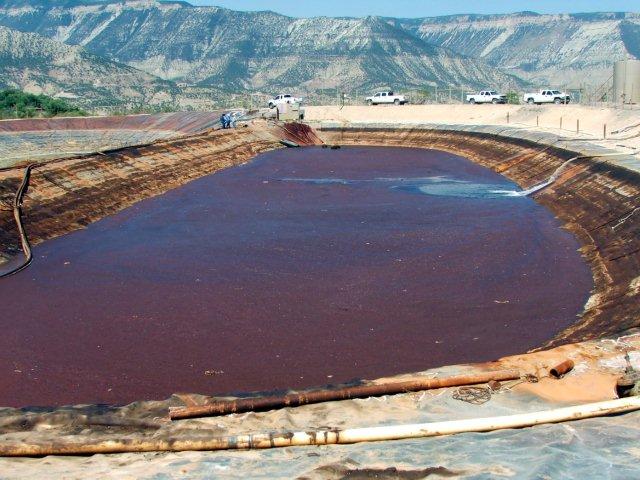
Jan 12, 2016
Blog Energy & Sustainability Weak Regulatory Oversight Threatens Human, Environmental Health, Group Says
Despite the Environmental Protection Agency’s (EPA) admission in a 1987 report to Congress that “oil and gas wastes contain various hazardous constituents,” oil and gas industry wastes remain exempt from the federal regulation.
A new report wants to change that, at least in six states in the U.S. West. No Time to Waste, which reviews regulation of radioactive oil and gas field wastes in Colorado, Idaho, Montana, North Dakota, South Dakota, and Wyoming, finds that the storage, transport, and disposal of radioactive oil and gas field waste are vastly under-regulated.
The report calls for stronger federal regulation of radioactive oil and gas waste and more rigorous and comprehensive state standards.
“Without thorough, stringent, and effective regulation of this waste stream, Western communities are left vulnerable to serious health and environmental impacts,” says Bob LeResche, chair of the Western Organization of Resource Councils (WORC). A regional network of grassroots community organizations, WORC endeavors to build sustainable environmental and economic communities.
States regulate radioactive oil and gas field wastes through a patchwork of rules and policy guidelines that can invite questionable cost-cutting measures on behalf of companies. “Oil and gas companies essentially handle and dispose of radioactive waste at their own discretion,” LeResche says. “Some have resorted to the cheapest option, illegally dumping it,” he adds.
U.S. REGULATORY GLIMPSE
WHAT IS PRODUCED WATER?
Produced water is the highest volume of liquid discharge that is generated during the production of oil and gas, according to Lapham. It includes water naturally present in the reservoir (formation water or connate water), water previously injected into the reservoir (floodwater), condensed water from gas production.
“Water trapped between the pore spaces of rocks when they are formed is referred to as connate water,” Lapham explains. “When this connate water is extracted along with the hydrocarbon resource it is then called produced water. Produced water may be contaminated with chemicals used in the extraction process, heavy metals and naturally occurring radioactive materials (NORM).”
She adds that produced water has “traditionally been considered an undesirable by-product of oil and gas production. With water becoming more precious, increased environmental awareness and a number of other factors, produced water is increasingly being treated for use as a beneficial resource.”
PRODUCED WATER VOLUME
The oil and gas industry generates roughly 21 billion barrels of wastewater and millions of tons of solid waste, much of it carrying a mix of naturally occurring radioactive materials, according to Sharon Kelly. But unlike most other industries, the oil and gas industry benefits from an exception to national hazardous waste handling laws, Kelly writes, which “punts control of this radioactive waste from the federal government down to each individual state no matter how dangerous the waste might be.”
However, since the advent of horizontal drilling, hydraulic fracturing, and other advances in drilling technologies, the oil and gas industry has been linked to a rising number of health and environmental concerns, says WORC: the contamination of drinking water aquifers, the flaring, venting, and leaking of methane, the proliferation of oil and saltwater spills, and the degradation of local roads and other infrastructure from overuse and misuse.
Western states have struggled to keep up with radioactive waste from drilling. “Though North Dakota has occupied much of the spotlight on this issue, other states have begun to see a rising tide of radioactive waste, as well,” concludes the WORC report.
FRACKING UNDER SCRUTINY
Water is produced with oil and gas from hydraulic fracturing. Most of the fluids being produced when the reservoir is new will take the form of hydraulic fracturing fluids, also known as flowback water, according to Lapham. After the reservoir begins to mature, the flowback water
Lapham adds that “fracking is receiving a lot of scrutiny, however. Some industry professionals report that fracking contaminates drinking water by increasing levels of methane, radioactivity and toxic fracking fluids in groundwater near well sites. Fracking is reported to release BTEXs, which are harmful to the nervous system and may cause birth defects and cancer.”
Colorado, Wyoming, and Montana lack formal regulations around the waste stream. Of these three states, only Montana has begun to address radioactive oil and gas waste, according to a WORC news release. South Dakota has a radioactivity limit for solid waste disposal, but no other oil and gas field waste-specific regulations, while Idaho has a handful of regulations, but no statewide disposal limit.
Without thorough, rigorous, and consistent oversight from the state, especially in the face of a higher radioactivity limit,” Larry Heilmann, a retired biochemist from Fargo, N.D., said in a WORC statement on the report, “it is doubtful that the new rules will result in improvements on the ground.”

Electrical switches—devices that control the flow of electricity—are the backbon...

As the world accelerates toward net-zero emissions, hydrogen, and ammonia have e...

Hydrogen technology is widely used across industries like glass, fertilizer, met...

We are your trusted research partner, providing actionable insights and custom consulting across life sciences, advanced materials, and technology. Allow BCC Research to nurture your smartest business decisions today, tomorrow, and beyond.
Contact UsBCC Research provides objective, unbiased measurement and assessment of market opportunities with detailed market research reports. Our experienced industry analysts assess growth opportunities, market sizing, technologies, applications, supply chains and companies with the singular goal of helping you make informed business decisions, free of noise and hype.